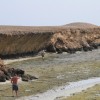Geoff Bailey travelled to Riyadh in early May to sign a new five-year Scientific Cooperation Agreement with the Saudi Heritage Commission.
Project updates
A new analysis of size variation in Conomurex fasciatus shells from the Farasan Islands has recently been published.
A new analysis of the spatial and temporal distribution of the Farasan shell mounds demonstrates major differences in rates of shell accumulation as a function of distance to the shoreline.
Welcome to the DISPERSE Project
DISPERSE - Dynamic Landscapes, Coastal Environments and Human Dispersals - is an Advanced Grant awarded by the European Research Council (ERC) under the Framework Seven Ideas Programme for a 5-year research project (2011-2016) involving collaboration between the Department of Archaeology at the University of York and the Institut de Physique du Globe, Paris.
The research is concerned with the relationship between geological instabilities resulting from active tectonics, volcanism and sea-level change, and patterns of early human evolution and dispersal over the past 2 million years.
The Project team is developing new methods of landscape reconstruction, using new technologies and techniques of aerial and submarine remote sensing, including exploration of the now-submerged regions that existed when sea-level was substantially lower than present.
The results are expected to illuminate the nature and causes of human dispersal out of Africa, and also to shed light on the underlying processes of long-term geological change and their impact on past human societies, with implications for how me may anticipate and cope with similar changes in the modern world.
The formal end of the project was on 31st March 2016, but all the members of the core team are continuing to follow up new lines of research arising from DISPERSE, and the early-stage researcher members have all moved on successfully to new research appointments. News of further activities, publications and progress will continue to be reported on this website.













